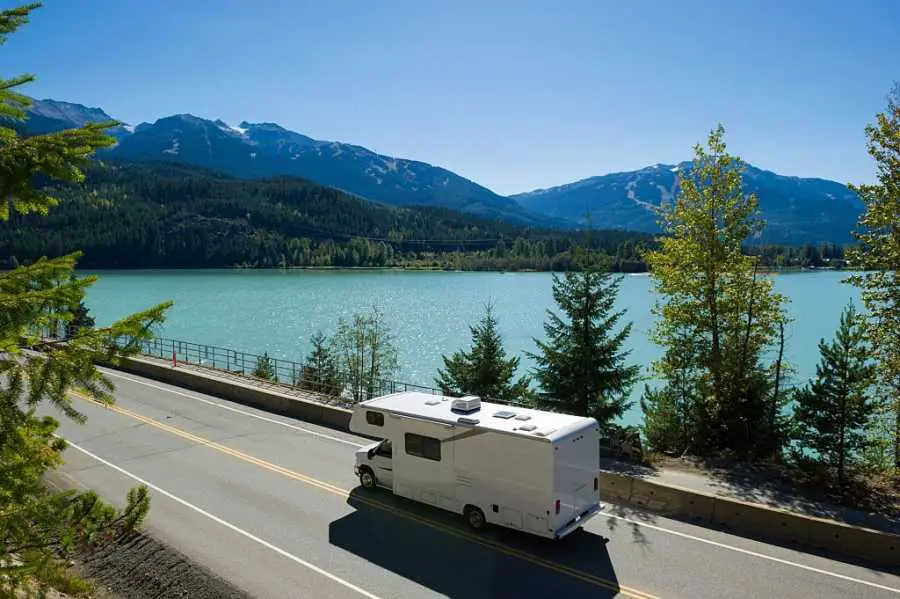To charge your RV battery while driving, you will need a converter that can convert 120 volts of AC power to 12 volts of DC. If your RV has this converter, then there are two ways you can try charging it on the go.
The first way is to plug your charger into the RV’s converter and connect it directly to your battery terminal leads. The downside of this is that it will reduce fuel economy by about 10%. The second, more efficient way is to install a solar panel on your roof or somewhere else on your roofline that will charge both the solar panel and your RV’s battery.
Preserving your RV battery life is very important, especially when you’re planning to use it for a more extended period. You can’t run an RV or use other amenities like the air conditioner when you have a low battery.
For these reasons, learning how to charge your RV battery while on the go will greatly benefit you. This article will highlight some of the common problems that cause battery drainage, maintenance, and charging, just to mention a few. And some emergency precautions.
Essentially, you will learn how to preserve your RV battery life, making it durable and efficient. Also, you will learn how to charge an RV battery while driving.
Let’s dive right in!
Table of Contents
Instructions on how to charge RV battery while driving

You can use different methods to charge your RV battery when on the road. While there are many methods you can find online, there is no guarantee that they will work.
However, the methods you will learn here will not only work rapidly but are efficient as well.
How RV batteries work
Most batteries you find in RVs are usually referred to as 12-volt batteries. Put simply, RV batteries should last over a prolonged period. RV batteries can stay longer when fully charged compared to other automobile batteries.
All the installations in your RV that use electric power drain the battery steadily. However, RV batteries are durable when properly maintained. In fact, they can work for decades provided they are well maintained.
But how do you ensure they are properly maintained? Well, first, you should research the model of the battery in your RV. You should charge it to full capacity to ensure you don’t interfere with its durability.
More importantly, if the battery is not in use, simply turn it off by unplugging the ground wire.
As a word of caution, you should never allow the RV battery to charge less than 50%. Remember to charge it to full capacity every time. Charging the battery to full capacity improves durability and will make it last longer.
Furthermore, an RV battery that is fully charged will have more voltage. As you know, voltage levels can determine the RV’s battery status.

Therefore, if you feel the RV isn’t performing as expected, then it means the battery has issues. There are several ways to determine the battery status. You can buy a battery monitoring testing kit to check your RV battery status.
Charging Your RV Battery Using A Voltage Controller Relay

Voltage Controller Relay is specialized on/off device with a switch that can regulate the auxiliary and starter battery power. When you switch off the RV, this device will also stay off, disconnecting the RVs starter battery.
Likewise, when you power the RV, the device will act as a bridge between the auxiliary and starter battery. An added advantage of using this device is that it always resets the battery voltage levels. What’s more, it operates automatically, thereby saving energy.
The VCR system usually disconnects automatically, parallels the RV auxiliary, and starts the batteries. But if the relay is shut off, the RV batteries remain parallel. And the moment you start your truck, the relay instantly starts.
Thereafter, the truck and trailer batteries disconnect when you turn off your truck. This adjusts the voltage to a preset level. After you have done this, connect the RV battery to your car’s main power source.
Key Takeaway
You are always advised to use quality cables and plugs when you are performing this process. It’s important to use high-end cables and plugs as they have the capacity to carry a huge quantity of energy. Additionally, they deliver a stable and reliable connection.
This helps to minimize voltage drop and maximize the charging power of the RV battery. Furthermore, a secure and stable connection will prevent your battery from disconnecting when you drive through a rough road.
Ensure you have connected the RV battery securely to your truck’s main power source to avoid ending up with a low battery charge during your road trip.
Alternatively, you should install rubber slips on the battery breakers to prevent short circuits as this can damage your battery. As a suggestion, you can buy the 50amp circuit breaker that resets automatically.
Install the circuit breaker on the positive side to eliminate any potential fire hazards. What’s more, you should avoid overcharging your RV battery. If you overcharge the RV battery accidentally, check the electrolyte levels and add water when required.
As you can see, charging your RV battery while on the move is not a difficult task. When you follow the above-listed steps charging your RV battery won’t be a hassle any longer. After all, you don’t want to get stuck in the middle of nowhere when the battery malfunctions.
And as mentioned earlier, you should get high-quality cables and plugs to ensure you always have a reliable connection.
Other ways of charging RV battery
Another way to charge an RV battery while driving is by using high-quality voltage cables. You can buy Anderson plugs, which maintain voltage when transferring energy to the battery. Ensure the voltage cable is attached to the RVs tow bar.
When you notice that things become heated up, there’s no need to worry. RV batteries usually have a pre-installed anti-hazard system. When the connection exceeds 50 amperes, the circuit protection function will usually shut down everything to prevent an accident.
Methods of charging RV battery while driving

Bulk ( or Boost stage)
This is the fastest way to charge your RV battery while driving. During the bulk phase, your RV battery uses most of the volts and amperes released by your charging device. This phase is often initiated if the RV battery is almost 0%.
Float Stage
The RV battery enters the float stage when it is about 90% charged. The charge will remain active and you will notice the battery has about 13 volts. During this state, the RV battery continues to get charged through a steady current flow.
Charge it with generator power.
As mentioned earlier, RV batteries are durable and efficient if you keep them in good condition. You can use a generator to charge the battery since most modern RVs are compatible with convertors and generators.
Nonetheless, determining what converter or generator suits your RV will depend on due diligence. Check out this guide on charging your RV battery with a generator.
Knowing your RV battery type

It is important to know the type of battery that your RV uses. For instance, some RVs can even store two batteries for better energy efficiency. Also, ensure you follow your manufacturer’s suggestions as far as the voltage is concerned.
Proper battery care will significantly affect its capacity, speed, and durability. Also, ensure the battery has optimal electrolyte levels.
Replenish the battery with distilled water if necessary. And as mentioned earlier, you should never allow your battery charge to drop below 20%.
Caution
The two main things you should avoid include overcharging and hot weather. These two are often interconnected most of the time.
In addition to checking that the battery has optimal electrolyte levels, you should keep things easy during the summer when it’s extremely hot.
The optimal duration required to charge the battery will depend on several things. For starters, the battery’s capacity/ size matters. You should also ensure you have a quality charger with excellent insulation.
If the charger has a reliable power transferring mechanism, then charging will definitely take less time.
Key Takeaway
Regularly check your RV’s battery electrolyte levels. Also, remember to replenish your battery with distilled water when required.
You should always keep your battery’s water level at about ninety percent, or it will overflow when charged. In addition, place the battery inside the RV in a dry place with temperatures above 32°F.
Never attempt to charge your RV battery when it’s frozen, as it might explode. Also, ensure the place where you store the RV battery isn’t vulnerable to flooding.
If you want the RV battery to last longer than usual, you should check on it regularly. Recharge it once a week.
Conclusion
Charging your RV battery is definitely possible when driving. However, you need proper knowledge and the right tools.
If you put this invaluable information to good use, you can ensure you preserve the RV battery life so that it can serve you longer. Remember always to charge the battery to full capacity.

